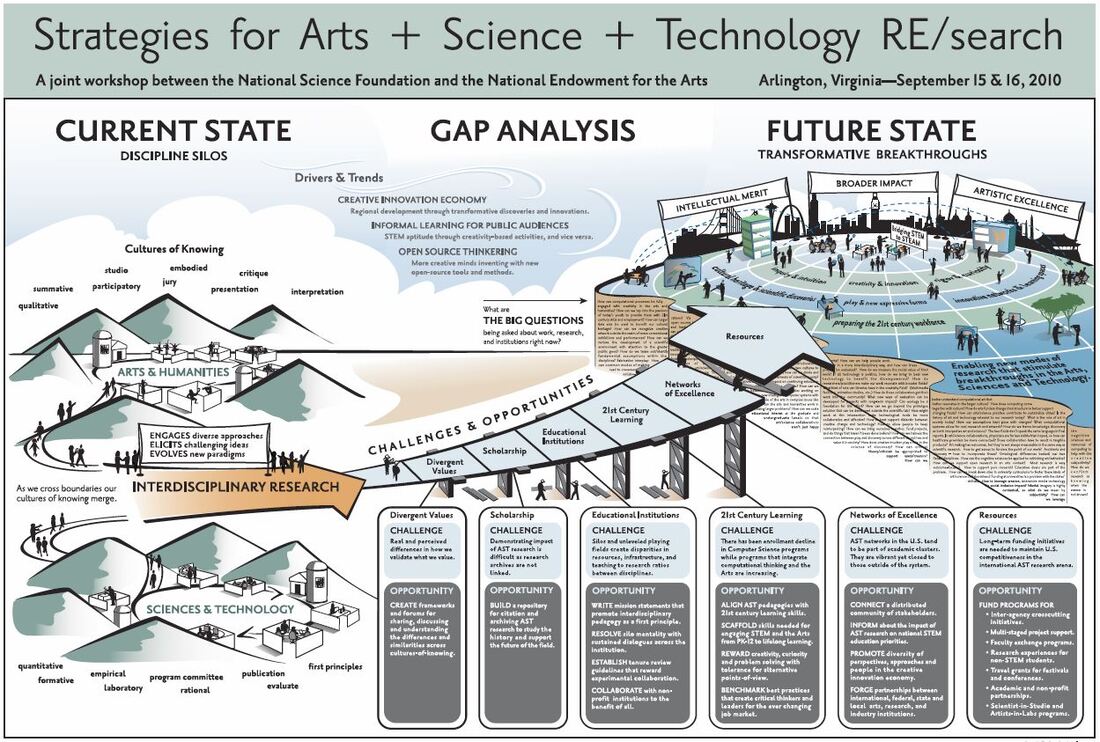PAMELA L. JENNINGS, PHD
|
PAMELA L. JENNINGS Ph.D., MBA
|
National Science Foundation & National Endowment for the Arts Partnership
Strategies for Art + Science + Technology Research StoryMap & Executive Report
Program Director
Strategies for Art + Science + Technology Research StoryMap & Executive Report
Program Director

|
Your browser does not support viewing this document. Click here to download the document.
|
Building a National Public/Private/Academic Network for a Transformative Research Platform.
The CreativeIT program served a research community with unique interdisciplinary methods and practices bridging STEM subjects common to the NSF Computer, Information Science, and Engineering (CISE) directorate and design. My goals in leading the program were two-fold. The first was to broaden outreach and increase the number of successful grant awards to creative technology researchers whose work was strongly situated both in formal notions of computer science and engineering and the fine (e.g., visual arts), applied (e.g., design, architecture, etc.), and performing arts (e.g., music, theater, interactive entertainment). This area of hybrid integrative research was rapidly growing, particularly in higher education. In many cases, CreativeIT research is as insightful about the impact of technologies on society as research from traditional STEM-only perspectives. The second goal was to build a national network to build a coalition for researchers and institutions in the CreativeIT ecosystem.
I funded a series of six workshops at universities across the United States to discuss the “state-of-the-field” of integrative research and education between STEM and the Arts and Humanities. Strategies for Arts + Science + Technology Research: A Joint Meeting of the National Science Foundation and the National Endowment for the Arts. Held at the NSF headquarters, this was a historical first collaboration between the National Science Foundation and the National Endowment for the Arts. The workshop brought together national and global academics, and U.S. federal agency leaders, to share synergistic goals to identify opportunities and foster collaborations between constituencies; create a gap analysis to understand the priorities required to sustain this form of integrative research; and develop a set of actionable areas of mutual interest. The NSF/NEA workshop results were summarized in an executive summary report and storymap poster. Both continue to be used today to support initiatives for integrative research and learning in higher education in the United States. The storymap poster has also been used to support integrative research initiatives in Europe and Canada. The storymap has inspired work in my current project as a White House Presidential Innovation Fellow at the U.S. Department of Transportation.
The CreativeIT program influenced several NSF grant programs in Computer Science, Social Behavioral Economics, and Education to fund integrative research grant proposals that included the Arts and Humanities as core components of the research project. Also, the CreativeIT program gap analysis workshops led to the formation of the Science, Engineering, Art, & Design (SEAD) national network. The SEAD network, led by four higher education leaders, continued advocacy work for institutional and federal support culminating in a consensus report of the National Academies of Sciences on integrative learning and research in higher education titled, Integration of the Humanities & Arts with Sciences, Engineering, & Medicine in Higher Education: Branches from the Same Tree.
The CreativeIT program served a research community with unique interdisciplinary methods and practices bridging STEM subjects common to the NSF Computer, Information Science, and Engineering (CISE) directorate and design. My goals in leading the program were two-fold. The first was to broaden outreach and increase the number of successful grant awards to creative technology researchers whose work was strongly situated both in formal notions of computer science and engineering and the fine (e.g., visual arts), applied (e.g., design, architecture, etc.), and performing arts (e.g., music, theater, interactive entertainment). This area of hybrid integrative research was rapidly growing, particularly in higher education. In many cases, CreativeIT research is as insightful about the impact of technologies on society as research from traditional STEM-only perspectives. The second goal was to build a national network to build a coalition for researchers and institutions in the CreativeIT ecosystem.
I funded a series of six workshops at universities across the United States to discuss the “state-of-the-field” of integrative research and education between STEM and the Arts and Humanities. Strategies for Arts + Science + Technology Research: A Joint Meeting of the National Science Foundation and the National Endowment for the Arts. Held at the NSF headquarters, this was a historical first collaboration between the National Science Foundation and the National Endowment for the Arts. The workshop brought together national and global academics, and U.S. federal agency leaders, to share synergistic goals to identify opportunities and foster collaborations between constituencies; create a gap analysis to understand the priorities required to sustain this form of integrative research; and develop a set of actionable areas of mutual interest. The NSF/NEA workshop results were summarized in an executive summary report and storymap poster. Both continue to be used today to support initiatives for integrative research and learning in higher education in the United States. The storymap poster has also been used to support integrative research initiatives in Europe and Canada. The storymap has inspired work in my current project as a White House Presidential Innovation Fellow at the U.S. Department of Transportation.
The CreativeIT program influenced several NSF grant programs in Computer Science, Social Behavioral Economics, and Education to fund integrative research grant proposals that included the Arts and Humanities as core components of the research project. Also, the CreativeIT program gap analysis workshops led to the formation of the Science, Engineering, Art, & Design (SEAD) national network. The SEAD network, led by four higher education leaders, continued advocacy work for institutional and federal support culminating in a consensus report of the National Academies of Sciences on integrative learning and research in higher education titled, Integration of the Humanities & Arts with Sciences, Engineering, & Medicine in Higher Education: Branches from the Same Tree.
Copyright © 1990 - 2024